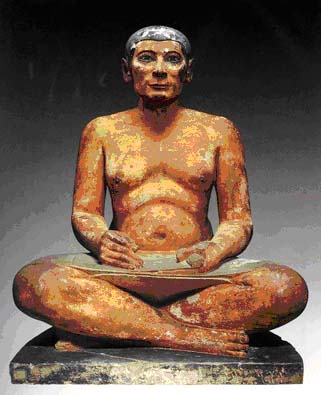The prince is portrayed half-naked, exposing his strong chest and shoulders, which signifies his power to conquer everything. The skin of Rahotep is reddish brown, for the prince, who often went to engage in battle, was exposed to the sun regularly. The skin of the princess, on the contrary, is fair and delicate, for she seldom left her chambers. Nofret wears her thick hair in a bob, which rings her delicate and pretty face. Her white long dress, adhering to her body, shows her full figure. The two statues display two different kind of beauty - the prince is strong and handsome; his wife, pure and gentle. This statuary is a classic of the Old Kingdom period in ancient Egypt.
|

|
The Seated Scribe
|
The sculpture of the Seated Scribe is one of most important examples of ancient Egyptian art. The sculpture was discovered at Saqqara in 1850 and dated to the period of the 4th Dynasty, 2620-2500 B.C. It is currently part of a permanent collection of Egyptian antiquities in the Louvre Museum in Paris.
The gestures and facial expression of the statue are extremely realistic. In ancient Egypt, a scribe was a petty officer that recorded the speeches and deeds of his master. Being low in the hierarchy, he could be sculptured free of the restrictions on the royal statuary. Listening attentively and preparing to take something down, the scribe was portrayed at work. The structure of the figure, minute but not redundant, was crafted with meticulous care and flawless artistry, which makes this work one of the most vivid statues in the Fourth Dynasty of ancient Egypt.
|

|
Tomb Stela of Amenemhat and His Family, Egyptian Museum
|
This masterpiece is a painted relief of the early 12th Dynasty in ancient Egypt's Middle Kingdom period. The painted relief is similar to a stereoscopic painting, in which the colored figures are slightly raised, while pictographic symbols are carved in the margins, explaining the meaning of the painting.
The composition of setting several figures on a line makes the relief simple and elegant. .
The members of a family are shown on this stela from the Assaif (tomb R4). The father and mother sit on a lion-legged bench with a low backrest. The mother has a basket out of which peeks the handle of a mirror. Between the parents sits their son Intef; they hold each other's hands and shoulders. The daughter-in-law at the right edge of the picture, identified as Hapy, stands before the offering table on which pieces of meat, a string of onions, and lettuce are piled; under it are two loaves of bread.
